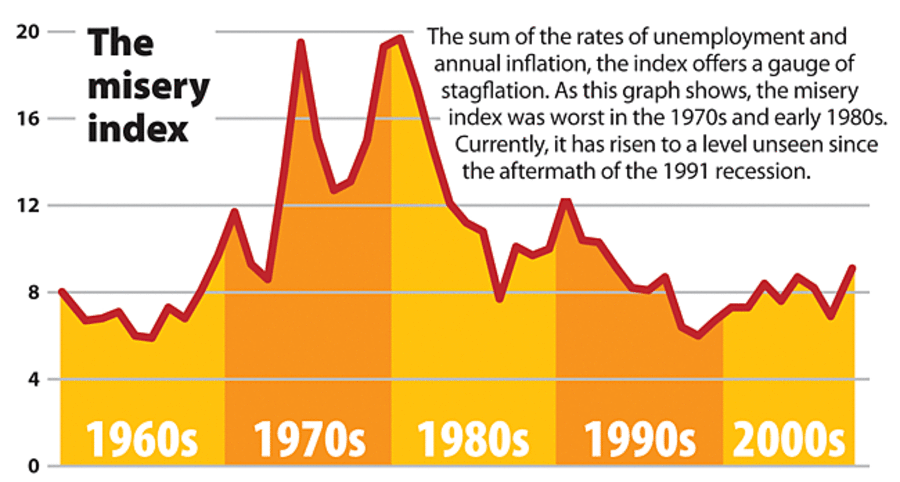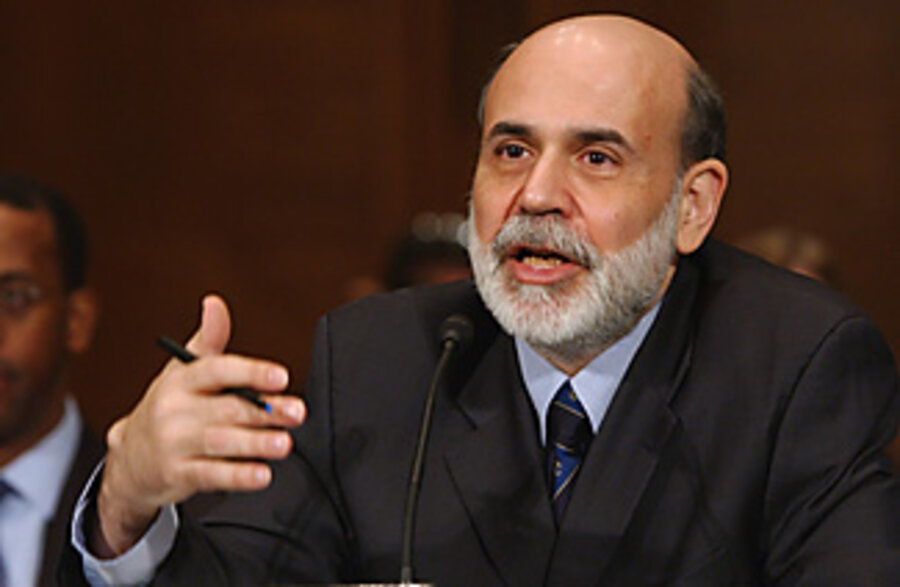Economic woes raise fear of 1970s rerun
The echoes seem ominous: a sagging economy, rising inflation, a record price for gold, and plunging stock prices. Could a return to 1970s-style stagflation be just around the corner?
That dreaded blend of economic stagnation and persistent rising prices is suddenly a topic of concern.
The word stagflation cropped up 562 times in major newspapers and wire services in February, compared with 12 times in the same month last year. Federal Reserve Chairman Ben Bernanke was asked about the danger last week on Capitol Hill. Democrats and Republicans alike peppered him with questions about soaring consumer prices, a sign that their constituents would prefer not to watch that 1970s show all over again.
Economists generally say a return of full-fledged stagflation is unlikely today. But what's already here is bad enough. The economy may have already entered a recession, and at the same time consumers face rising costs for everything from sandwiches to student loans.
"We're not going to see a replay of the 1970s in terms of the actual magnitudes" of unemployment and inflation, predicts James Hamilton, an economist at the University of California, San Diego. But the United States could see a period where "inflation goes up at the same time that real gross domestic product and employment stagnate."
One informal gauge of stagflation, the so-called "misery index," represents the sum of the unemployment rate and change in consumer prices over the past 12 months. Now in the 9 percent range, the index stands at less than half the peak it reached in 1974.
Still, with inflation up more than 4 percent and a jobless rate at 5 percent, the index in December hit a year-end level not seen since 1993, when the economy was struggling to find its footing after a recession.
This has affected the financial mood. Heightened worry is showing up in consumer confidence indexes, and on Friday the US stock market took a big dive.
The Federal Reserve is trying to guide the economy through this rough patch, but for now, it is in a bind.
The central bank is cutting interest rates to stimulate activity by banks, consumers, and businesses. But the easing of monetary policy runs the risk of allowing inflation to run hotter than the Fed likes.
The Fed acknowledges that the key factor here is expectations. If everyone believes that the Fed will eventually keep inflation in check, its strategy should work. "There's no way the modern Federal Reserve would chase inflation up into the double digits," as in the 1970s, Mr. Hamilton says. "They made that mistake once, and they won't make it again."
Still, it's clear that the Fed's credibility is on the line.
Both the record price of gold (now nearing $1,000 an ounce) and a record low exchange rate of the dollar against the euro stem partly from renewed concern about inflation, analysts say. If the general level of prices starts accelerating, it can erode the purchasing power of US currency.
Some economists, Hamilton included, believe that inflation could prove harder to contain than the Fed appears to believe. Still the central bank has won significant credibility since the 1970s, and now is a moment when, arguably it can expend some of that reputational capital.
In testimony before Congress, Mr. Bernanke said the biggest risk to the economy now is that growth will weaken, not that inflation will accelerate.
"I don't anticipate stagflation," he said. "I don't think we're anywhere near the situation that prevailed in the 1970s. I do expect inflation to come down."
Many economists agree that the current period differs from the 1970s. Both decades saw energy prices soar and the dollar dwindle. But back then, lax Fed policy was a key culprit – since inflation generally results when the supply of money is greater than what the economy needs for normal growth. Today, although the Fed has its critics, key measures of the money supply appear to be in better control.
The 1970s oil-price spikes may have contributed to slower productivity growth, to a degree not seen in the current cycle.
Worker contracts often called for wages to rise with the cost of living. That made people expect a so-called wage-price spiral.
"I lived through stagflation," says Ken Mayland, who heads ClearView Economics near Cleveland. Stagflation isn't just a period of economic weakness and inflation, he says. "It's a chronic situation where the expectation of higher inflation gets embedded into both the price-setting and wage-setting processes. And it tends to be stubborn."
Today, with the job market weakening, the pace of wage growth also seems to be cooling. Fed economists figure that a weak economy will pinch the ability of firms to pass costs along to consumers.
The Fed has a mandate from Congress to pursue both stable price levels and full employment in the economy. For now, the Fed is focused somewhat on the second goal. It hopes that low interest rates will help offset a pullback in lending as banks absorb big losses from mortgage loans.
Still, Bernanke didn't dismiss the risk of stagflation out of hand. If inflation expectations start to rise, he said the Fed will need to respond by raising short-term interest rates.
In the long run, policymakers believe that price stability is the most important Fed goal because it provides a crucial foundation for a strong job market.
Fairly or unfairly, this makes the Fed's current strategy look risky. "Some people might argue that the Fed's not paying enough attention to the price stability goal," Mr. Mayland says. "I would not be surprised to see … some calls for Bernanke to step down out of dissatisfaction."






